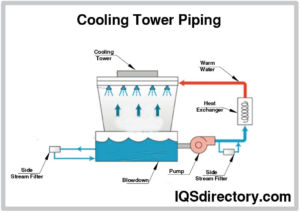An open type cooling tower, also known as an open circuit cooling tower, is a heat rejection system that uses direct contact between warm water and air for cooling purposes. Here’s a breakdown of how it works:
- Structure: It’s an enclosed shell with some key components:
- Water distribution system: Sprays warm water over a large surface area.
- Fill material: Creates a labyrinth-like path for the water to trickle down, maximizing contact with air.
- Fans: Draw in outside air and circulate it through the tower.
- Cold water basin: Collects the cooled water at the bottom.
- Cooling Process:
- Warm water is pumped to the top of the tower and distributed by the water distribution system.
- As the water trickles down the fill material, it has a large surface area exposed to the air flow from the fans.
- Heat transfer occurs between the water and air.
- Additionally, a small amount of water evaporates due to the air contact. This evaporation absorbs heat, further cooling the remaining water.
- The cooled water is collected in the basin at the bottom and then recirculated for its intended use.
- The hot, moist air exits the top of the tower.

Cooling Tower Piping
Advantages of Open Type Cooling Towers:
- Simple design and construction
- Lower initial cost compared to closed-circuit cooling towers
- Very effective cooling, especially in dry climates
Disadvantages of Open Type Cooling Towers:
- Water usage and loss due to evaporation (makeup water required)
- Potential for mineral scaling and biological growth requiring maintenance
- Emissions of water vapor plume which can be visible and may cause concerns in some areas
Applications of Open Type Cooling Towers:
- Power plants
- Industrial processes
- HVAC systems for large buildings
- Refrigeration systems
Looking to install a commercial HVAC System or Duct work in your Business Area?
Contact Vipul Ac to learn about our HVAC Service
Call +91 9825636606 Today.
